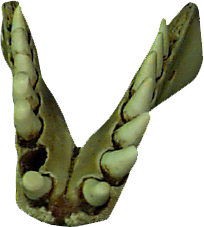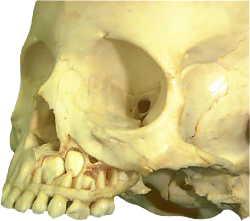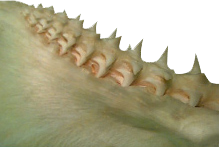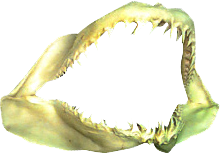Monophyodont, Diphyodont and Polyphyodont
Monophyodont
 Dentitions can be classified by the number of sets of teeth. Monophyodont
Dentitions can be classified by the number of sets of teeth. Monophyodont means "having one set of teeth". Animals like the beluga whale (shown right) have only one set of teeth in their lifetime. The aquatic mammals (Cetacea) include a group of toothed whales (Odontoceti) that are mostly homodont
means "having one set of teeth". Animals like the beluga whale (shown right) have only one set of teeth in their lifetime. The aquatic mammals (Cetacea) include a group of toothed whales (Odontoceti) that are mostly homodont and monophyodont
and monophyodont . Others in this group include the dolphin, the porpoise and the narwhal.
. Others in this group include the dolphin, the porpoise and the narwhal.
Beluga whale mandible (frontal view)
Diphyodont
Diphyodont means "having two sets of teeth". Mammals usually have two dentitions and these are termed the primary (deciduous) dentition
means "having two sets of teeth". Mammals usually have two dentitions and these are termed the primary (deciduous) dentition and the secondary (permanent) dentition
and the secondary (permanent) dentition . Man is an example of a mammal that is classified as diphyodont. Man has a primary (deciduous) dentition that generally begins to erupt at approximately six months of age. By approximately two and a half years of age, the primary dentition is complete. A total of twenty teeth comprise this primary dentition and are erupted by that time. The secondary (permanent) dentition begins to erupt at approximately six years of age. Both primary and secondary (permanent) teeth are present through a mixed dentition period
. Man is an example of a mammal that is classified as diphyodont. Man has a primary (deciduous) dentition that generally begins to erupt at approximately six months of age. By approximately two and a half years of age, the primary dentition is complete. A total of twenty teeth comprise this primary dentition and are erupted by that time. The secondary (permanent) dentition begins to erupt at approximately six years of age. Both primary and secondary (permanent) teeth are present through a mixed dentition period which lasts from age six to approximately eleven and a half years of age. Secondary (permanent) teeth continue to erupt until the late teens or early twenties. The total number of teeth in the secondary (permanent) dentition of man is thirty-two.
which lasts from age six to approximately eleven and a half years of age. Secondary (permanent) teeth continue to erupt until the late teens or early twenties. The total number of teeth in the secondary (permanent) dentition of man is thirty-two. The skull of a 5 year old (shown right) illustrates an intact fully erupted primary (deciduous) dentition in the maxillary arch. Some of the tooth buds of the developing secondary (permanent) dentition are visible.
The skull of a 5 year old (shown right) illustrates an intact fully erupted primary (deciduous) dentition in the maxillary arch. Some of the tooth buds of the developing secondary (permanent) dentition are visible.
Skull (5 year old)
Polyphyodont
The term polyphyodont refers to dentitions that have an endless succession of teeth. The dentition of the shark represents the polyphyodont dentition. Teeth are exfoliated or lost and are soon followed by replacement tooth. Amphibians with teeth, such as the frog (Rana temporaria) and the mud puppy (Necturus maculatus) are examples of dentitions that are homodont (teeth all the same) and polyphyodont (multiple sets of teeth). Reptiles are also generally homodont and polyphyodont. The iguana (Iguana iguana) is an example of this type of dentition.
refers to dentitions that have an endless succession of teeth. The dentition of the shark represents the polyphyodont dentition. Teeth are exfoliated or lost and are soon followed by replacement tooth. Amphibians with teeth, such as the frog (Rana temporaria) and the mud puppy (Necturus maculatus) are examples of dentitions that are homodont (teeth all the same) and polyphyodont (multiple sets of teeth). Reptiles are also generally homodont and polyphyodont. The iguana (Iguana iguana) is an example of this type of dentition.

Shark mandible (medial view)

Shark jaw (frontal view)


